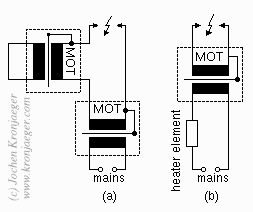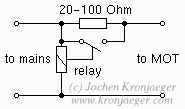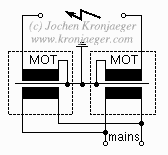Microwave oven transformers
Microwave ovens contain a very powerful high voltage transformer (MOT = microwave oven transformer), see photo. A typical output voltage is 2kVeff, at around 1000W power. This is equivalent to about 0.5Aeff output current @ 2kVeff output voltage. The short-circuit current is even higher.

|
MOT. Transformer from microwave oven. Primary winding (lower, thick wire) 230V, secondary winding (upper, thin wire) 2kV. The few turns of very thick wire wound on top of the secondary supply about 3V at a few A to the magnetron filament.
|
However, MOTs are not internally current limited (like OBITs are). And as an arc is pretty much a short-circuit for the secondary winding, the output current should be externally limited for the purpose of drawing arcs. This can be done by inserting a resistive or inductive load into the primary or secondary circuit, see figure. When using a transformer (e.g. another MOT) as an inductive load, the secondary winding of this transformer may be short-circuited to reduce it's inductive impedance. Without current limiting, chances are good that the mains fuse will blow when drawing an arc. With or without current limiting, the secondary will probably overheat when arcing takes place over long time.

|
Figure (a) shows secondary-side current limiting using a second MOT (with shorted primary) as ballast. Figure (b) shows primary-side current limiting using a heater element (the bigger the better).
|

|
When using secondary-side current limiting, remember that the limiting element is at full output voltage! In particular, when using a transformer with a grounded winding as in the figure, the transformer core is also at high voltage and must not be touched.
|
In spite of not being noticeably current limited, with all MOTs I've tested so far I could draw an arc without the fuse blowing, but the winding heats up within seconds!
When connecting a MOT to the mains (i.e. switching it on), there may be a very high current for some very short time. This may be enough to blow the fuse. This problem can be avoided by using a so-called switch-on current limiting circuit, see figure. Such a circuit is used in all microwave ovens and should be saved as well when cannibalizing such a device. After switch-on, the resistor limits the current to a sensible value for the short time the relay needs to switch.

|
Simple switch-on current limiting circuit. The relay must be suitable for direct control by mains voltage, and must be capable of switching a few Amps. The resistor must be a high power (wire-wound) type capable of at least several Watts.
|
Correct grounding is important with MOTs. The inner end of the secondary, which is near to the core, should be connected to the iron core. In many MOTs, this is already the case. The reason is that the insulation between core and winding is usually insufficient to withstand the full output voltage. Therefore, like OBITs, MOTs cannot be connected in series to increase output voltage. Only two MOTs can be used for double output voltage, when the cores are connected and the primaries anti-parallel, see figure below. However, in principle arbitrarily many MOTs may be paralleled for higher output current (although usually not more than two can be run on the same mains outlet).

|
Circuit with two MOTs giving 4kV output voltage between the two secondaries. Note that between each of the outputs and ground there is still only 2kV. Each of the two blocks marked by dashed lines symbolizes one MOT, with one end of it's secondary connected to the core. Together, the act like one transformer with a center-tapped secondary.
|

|
MOTs are very dangerous due to their high output current. Touching the high voltage end will probably result in death, at least in very severe burns.
Although the voltage is not very high, it is high enough to jump an air gap and thus makes the "one hand in the pocket" rule useless.
|
This document is copyrighted. All rights reserved. No part of this document may be reproduced without my permission. Permission to copy and publish this document or parts of it on the WWW is granted until explicitely revoked, under the condition that it is accompanied by this or a simliar copyright notice, including my name and the original URL.





